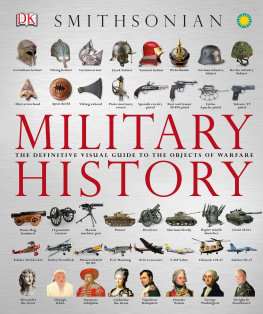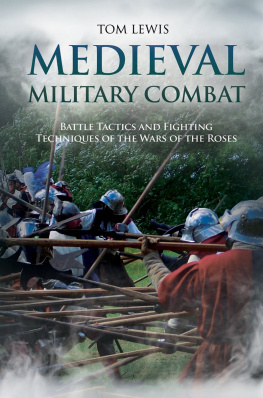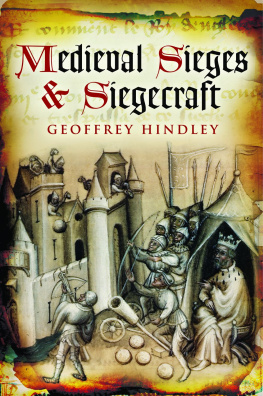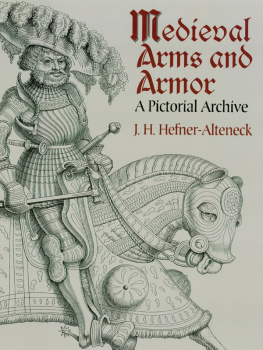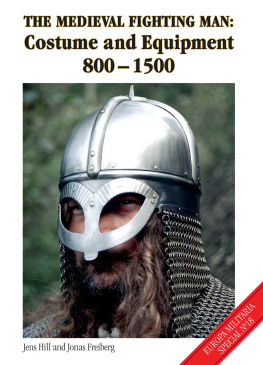MEDIEVAL MILITARY TECHNOLOGY
MEDIEVAL MILITARY TECHNOLOGY
SECOND EDITION
Kelly DeVries and Robert Douglas Smith
Copyright University of Toronto Press Incorporated 2012
Higher Education Division
www.utppublishing.com
All rights reserved. The use of any part of this publication reproduced, transmitted in any form or by any means, electronic, mechanical, photocopying, recording, or otherwise, or stored in a retrieval system, without prior written consent of the publisheror in the case of photocopying, a licence from Access Copyright (Canadian Copyright Licensing Agency), One Yonge Street, Suite 1900, Toronto, Ontario M5E 1E5 is an infringement of the copyright law.
Library and Archives Canada Cataloguing in Publication
DeVries, Kelly Robert, 1956
Medieval military technology / Kelly DeVries and Robert Douglas Smith.2nd ed.
Includes bibliographical references and index.
Issued also in electronic formats.
ISBN 978-1-4426-0497-1
1. Armor, Medieval. 2. ArtilleryHistory. 3. FortificationHistory. 4. WarshipsHistory. 5. Military history, Medieval. I. Smith, Robert Douglas II . Title.
U 810. D 48 2012 355.009'02 C 2012-902147-4
We welcome comments and suggestions regarding any aspect of our publicationsplease feel free to contact us at news@utphighereducation.com or visit our Internet site at www.utppublishing.com .
NORTH AMERICA
5201 Dufferin Street
North York, Ontario, Canada,
M 3 H 5 T 8
UK, IRELAND, AND CONTINENTAL EUROPE
NBN International
Estover Road, Plymouth, PL 6 7 PY , UK
Orders
PHONE : 18005659523
FAX : 18002219985
E-MAIL : utpbooks@utpress.utoronto.ca
2250 Military Road
Tonawanda, New York, USA , 14150
Orders
PHONE : 44 (0) 1752 202301
FAX : 44 (0) 1752 202333
E-MAIL : enquiries@nbninternational.com
Every effort has been made to contact copyright holders; in the event of an error or omission, please notify the publisher.
The University of Toronto Press acknowledges the financial support for its publishing activities of the Government of Canada through the Canada Book Fund.
CONTENTS
CHAPTER 1
ARMS
CHAPTER 2
ARMOR
CHAPTER 3
THE STIRRUP, MOUNTED SHOCK COMBAT, CHIVALRY, AND FEUDALISM
CHAPTER 4
NON-GUNPOWDER ARTILLERY
CHAPTER 5
GUNPOWDER ARTILLERY
CHAPTER 6
SIEGE MACHINES
CHAPTER 7
EARLY MEDIEVAL FORTIFICATIONS
CHAPTER 8
THE MOTTE-AND-BAILEY CASTLE
CHAPTER 9
STONE CASTLES
CHAPTER 10
URBAN FORTIFICATIONS AND FORTIFIED RESIDENCES
CHAPTER 11
EARLY MEDIEVAL WARSHIPS
CHAPTER 12
HIGH AND LATE MEDIEVAL WARSHIPS
ILLUSTRATIONS
ACKNOWLEDGMENTS
IT MAY BE MORE DIFFICULT TO WRITE THE ACKNOWLEDGEMENTS OF THE second edition of a book than it is the first edition. Having to combine the reasons why a book was initially written, and thanking those who helped in that initial writing, with what prompted a second edition to be written, with those who helped there, is not easy. Often, lots of time has passed between the two editions, twenty years in the case of this book, and many things change during that time. (For one thing, the authorship of this book has gone from one to two.) Perhaps that is why so many authors simply attach their new acknowledgements to the bottom of their original ones. To keep from repeating things, as well as try to express thanks to people who have helped me both before the appearance of the first book, and since, I will try to combine the two sets of acknowledgements. As the first acknowledgements were written alone by me, Kelly DeVries, I am writing these, with some comments by Robert Douglas Smith added at the end.
This book was first suggested to me in 1988, when I was teaching as a sessional lecturer in the Department of History at the University of British Columbia, by my department chairman, Professor Richard W. Unger, whose own works on the history of medieval technology have established (and continue to establish) him as one of the giants in the field. As he pointed out to me, the history of medieval military technology has been largely left up to amateur historians and antiquarians whose interests in the field were derived largely from their desires to replicate, in re-enactments and wargames, the arms, armor, and castles of the medieval warrior. Numerous books and articles from professional medieval and arms and armor historians have appeared, it is true, but no one book had been devoted to an overview of all medieval military technology. This was further emphasized in studying the then-profusion of recent general works on technology and war, all of which give but little space to the discussion of the Middle Ages, especially in comparison to ancient and modern military technology. To Professor Unger for suggesting this to me, I give special thanks.
In the original acknowledgements, I also thanked my mentor in the history of technology, Professor Bert S. Hall, then Professor at the Institute of History and Philosophy of Science and Technology at the University of Toronto. In carrying on the tradition of his own mentor, Lynn White, Jr., his discussions with me, both in graduate school and since my graduation, and with Bob, since meeting him more than a decade ago, have been of untold assistance as we puzzled through the intricacies of studying a historical genre in which one frequently must look beyond the written text. His encouragement of us in this and many other endeavors, as well as his diligence in scrutinizing whatever we send him, has been invaluable. Bert has, since the original edition of this book, retired from full-time teaching at the University of Toronto, but he continues to be the fount of technological knowledge we turn to often.
In the first edition, I also praised the Centre for Medieval Studies at the University of Toronto, my graduate school, for preparing me with the linguistic and historical necessities medieval historians need to research in medieval history. Now, as it nears 25 years since that graduation date, I look back with an extremely fond remembrance of what may have been the best years of my life, living in one of the great cities in the world, Toronto, which provided then, and continues to provide now, such a great base for engulfing oneself completely in the Middle Ages, and working with some of the best professors and fellow students in the field. One of the greatest thrills in my professional life was returning to campus after about fifteen years and meeting with some of these professors, and to be told by two of them how proud they were of what I had accomplished with what they had taught me. I know I can speak for all of the University of Toronto alumni in thanking you, kind and diligent men and women, for being such influences and examples.
While visiting one of the earliest International Medieval Congresses, sponsored each summer by the University of Leeds, I had the great fortune to meet Bob Smith and his wife, Ruth Brown. The Royal Armouries, at which Bob was the Head of Conservation, had just moved to Leeds, and he came to the Congress to speak on early gunpowder weapons, something I had considered up to then that I had a pretty good knowledge of. Within only a few minutes of his presentation, and in several discussions since, I realized that I was but an amateur in the field. This meeting almost immediately bore fruit, as a couple of school years later, 199899, was my first sabbatical at Loyola College (now University) where I became employed the year that this book was published. That sabbatical year soon turned into eighteen months when, added to the honor of holding a Senior Fellowship at the Dibner Institute for the History of Science and Technology, Massachusetts Institute of Technology, I received a Professional Development Fellowship by the National Science Foundation, Science and Technology Studies to study the history of gunpowder weapons with Bob at the Royal Armouries, the idea being to marry my expertise as a historian with his as an artefactual scholar. We have never looked back. The work done that year eventually resulted in our first book together,
Next page

